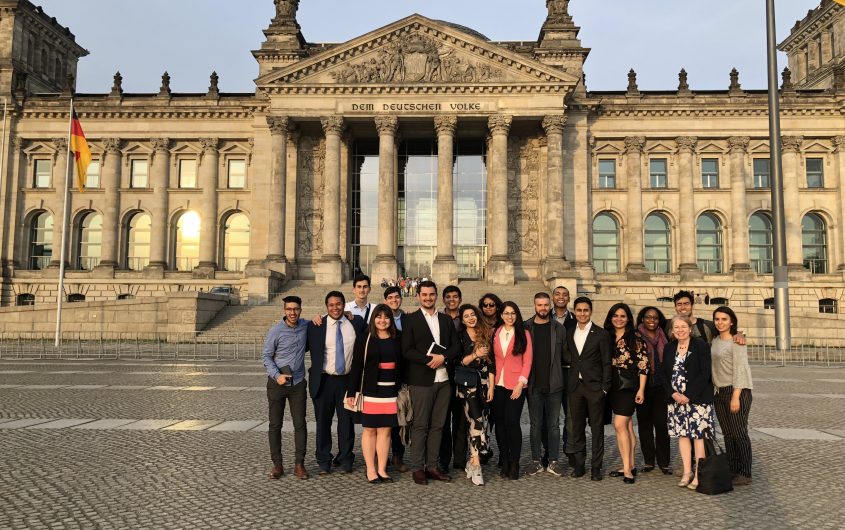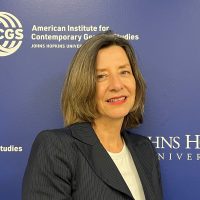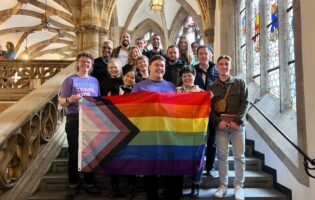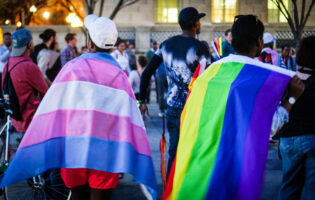
AICGS
Exploring Immigration and Integration Initiatives in Germany

Elizabeth Hotary
Communications Officer
Elizabeth Hotary is the Communications Officer at AICGS. She creates and implements communications strategies, coordinates publishing activities, and manages media relations. She contributes to AICGS research on workforce education and immigration and integration and has co-led AICGS study tours across the United States and Germany. Before joining AICGS, she taught English at a secondary school in Herne, Germany, as part of the Fulbright Program. During her time as a Fulbrighter, she also volunteered with the U.S. Consulate Düsseldorf’s MeetUS program, where she traveled to schools across North Rhine Westphalia to speak with secondary school students about the United States. She has previous experience at the University of Denver's Josef Korbel School’s Office of the Dean and WorldDenver, a nonprofit global affairs organization.
Ms. Hotary received her MA from the Josef Korbel School of International Studies at the University of Denver, where she was a Marc Nathanson Fellow. She graduated magna cum laude from the University of Arkansas with degrees in International Relations, European Studies, and German. She is an alumna of the Aspen Seminar for Young European Leaders "Next-Gen Europe: Leading for Values."
__

Susanne Dieper
Director of Programs and Grants
Susanne Dieper is the Director of Programs and Grants at AICGS. She oversees the Institute’s programs and projects within the three AICGS program areas, manages all AICGS fellowships, and is in charge of grant writing. Her current focus is on issues related to transatlantic relations, immigration and integration, diversity, the next generation of leaders, workforce education, and reconciliation. She develops programs that align with the mission of AICGS to better understand the challenges and choices facing Germany and the United States in a broader global arena.
Previously, Ms. Dieper was in charge of organizational and project management at AICGS as well as human resource development and board of trustees relations. Prior to joining AICGS, she worked in transatlantic exchange programs, language acquisition, as well as the insurance industry in Germany.
Ms. Dieper holds an MBA from Johns Hopkins University with a concentration in International Business and an MA in English Linguistics and Literature, History, and Spanish from the University of Cologne. She has completed course work in nonprofit management at Johns Hopkins University.
__
AGI Minority Exchange Program
Immigration and integration challenges are at the forefront of policy discussions in the U.S. and Germany. How can our societies adapt to newcomers and what services will we need to provide? Are we doing enough to help immigrants integrate so that they can become successful members of society? These and other questions were addressed during a week-long program in Berlin, Germany.
Visit to a Migrant Welcome Center
The Arrival Center at Tempelhof Airport in Berlin is the first stop for newly arrived asylum seekers in Germany and now houses about 340 people. It is run jointly by TAMAJA and the Berlin State Office for Refugee Affairs. From August 2015 to March 2016, the center was an emergency refugee shelter that provided for 600-750 people per month—about 8,000 per year. Now, new arrivals are typically moved after five days to communal houses, including those that have been built on the airfield at Tempelhof. More broadly, 1,200 people still live in shelters in all of Germany. Those are to be closed by the end of the year. Security continues to be a serious, if contentious, issue particularly when entering the Arrival Centers. Registration at the Arrival Centers includes taking fingerprints, biometric information, and documents the people have brought with them.
The challenges of caring for new arrivals include the difficulties of communal housing, e.g., shared showers and kitchen. The city of Berlin is experiencing a lack of housing, in part because it has seen a rise in its overall population (migration from within Germany and Europe to Berlin). Generally, the Arrival Center’s administration strives to maintain transparency and offers tours to visitors and NGOs. There is not much cooperation with other countries on how to best deal with an influx of refugees. Most European countries, in particular Italy and Turkey, are overwhelmed by the sheer numbers they have received.
The participants were struck by the transparency displayed and drew comparisons to the U.S. situation, where arrival centers are called detention centers and visits or tours are not permitted.
Panel I: Political Institutions and Immigration
Berlin is a growing city and has seen a large influx of people from other European countries. One-third of its population has a migration background. Historically, Berlin has been divided and poor. The minority population is predominantly from Turkey, Poland, Russia, Syria, and Italy. The Participation and Integration Act changed the way Germany deals with newcomers. While the federal government sets the framework for the country in terms of immigration and integration, the states, including Berlin, implement different programs. One program is called Integrationslotse (integration pilots) and connects newcomers with citizens of Berlin who share a similar background. There are about forty integration indicators that are used to measure integration success. The indicators measuring labor market access and education success are those cited most often in integration assessments. The campaign “Berlin needs you” has focused on recruiting staff with minority backgrounds and targets schools, government departments, and police departments. While the decision-makers are still white, serious efforts are being made to change this.
Migration to Germany is not a new phenomenon and has been a factor for modern Germany after World War II. Now about 22 percent of the population has a minority background. Germany would benefit from immigration, in particular given its aging society. The organization Deutscher Soldat was founded as a way to combat stereotypes of Germans with a migration background and to demonstrate the positive impact migration has had on the Bundeswehr and Germany. Another movement called Neue Deutsche Organisation has followed and is a growing movement that aims to influence policymaking.
The participants emphasized the importance of inclusion policies in both the U.S. and Germany as well as the discussion of identity. It is important for both countries to recognize that diversity is moving the country and society forward and has a positive impact. German identity discussions are once again prevalent at many levels of society and may be a first step to establishing a vision for the country.
Panel II: Immigration and Politics
The political foundations in Germany act as think tanks to their affiliated parties. The Boell Stiftung was actively responding to the migration crisis in 2015/16 by sharing information and developing a working group on how Germany can improve its immigration policies. The foundation has published papers on a variety of issues related to the topic, including the root causes of flight, and routinely makes policy recommendations. It has also solicited country reports, e.g., on Somalia, and conducted interviews with refugees across the world in order to include their input into the policymaking process.
Immigration and politics continue to be intertwined in Germany. The bureaucracy was confronted with over 700,000 asylum applications and Germany has struggled with the new situation of handling the roughly one million people who entered the country in 2015/16. The weekly polls asking the population what the biggest problems and challenges are in Germany suggest that issues related to foreigners, integration, and refugees remain high on the agenda. Political responses have followed. The sensitive debate now includes the need for skilled workers as well as the humanitarian aspect. However, populist responses are also numerous. The Konrad Adenauer Stiftung emphasizes the sensitivity of the issue and the political responses.
The Friedrich Ebert Stiftung has focused its work on explaining the causes of displacement and provides information on migration on its website. It works directly with the refugees with the aim of showing that Germany is a democracy. The foundation offers workshops for refugees as well for Germans on how to provide support. It also showcases what integration policy in Germany should look like and refers to the public discourse on German identity. It has created a pamphlet on how integration ideally should work. It has also emphasized that migration is a normality and not a crisis. Germany should shape and create smart policies in response to this normality.
On the question of identity and who is German, a poll by the Humboldt University in Berlin suggests that 90 percent of those questioned believe passport and language skills are indicators of nationality. German ancestry (blood relations) was not one of the top indicators. Regarding the question of how many people with a minority background are involved in or working at the foundations, relevant data was not available. The participants urged the foundations’ representatives to have that kind of data available.
Panel III: Integration and Communities
Panel III focused on two issues: diversity and inclusion in business and the political discourse surrounding immigration and integration in Germany. AT&T is committed to promoting diversity within its own company and believes that diversity and inclusion are foundations of good business. All employees are required to take courses on inclusion. Their human resources department works to recruit diversely and is consistently evaluating its own success; at the time of the presentation, 55 percent of AT&T employees were white. AT&T’s awareness of its own diversity statistics were impressive to the participants. They found throughout the program that German institutions were unlikely to collect data on employee diversity. AT&T has found that the focus on diversity and tolerance is beneficial to employees. Not only that, AT&T recognizes the market strength of diverse communities.
Immigration is a hot topic in Germany, but the political discourse around it has led to the rise of far-right parties. The Alternative for Germany (AfD) not only drew 13 percent of the vote in the federal parliamentary elections in September 2017, they also have influenced the language of how Germans talk about immigration. They normalize scandalous comments about refugees and people with migrant backgrounds. Meanwhile, other political parties debate whether Islam is a part of Germany, instead of issues of inequality, NATO power, the euro, and future refugee crises.
Panel IV: The Challenges and Opportunities of Immigration and Integration
The German interior minister Horst Seehofer recently gave the Ministry of the Interior a new name, which includes Heimat (Home affairs). Integration work is one component of the new structure. Integration has been a topic in Germany for the last 2,000 years. Central Europe has always experienced migration and it was pronounced after World War II. During the 1960s and 1970s, Germany’s guest worker program brought workers mainly from Turkey and Italy to the country; they then remained in Germany. The 1990s saw an increase in asylum-seekers from the Balkans. Reunification saw another wave of internal migration. Similar to the United States, Germany’s population is changing. It is important to highlight the opportunities, rather than the threats, that come along with a diverse population. The political fights in the late 1990s regarding integration laws led to the migration law (Zuwanderungsgesetz) of 2005. In 2016, a new integration law (Integrationsgesetz) was passed that aims to facilitate the integration of refugees via work and training opportunities, and outlines the obligations to refugees in Germany.
SINGA was founded three years ago in light of the challenges and opportunities of integration. SINGA provides spaces for newcomers to come together to explore employment opportunities, and it matches business ideas of refugees/newcomers with existing structures and companies as well as individuals. There are several challenges:
- Expectations need to be managed regarding what newcomers and locals can achieve together.
- Companies saw an opportunity with the refugee influx because of the labor shortage. They met with Chancellor Merkel and formed the initiative “Wir zusammen” to promote hiring refugees in German companies. However, the concept was not well thought through and many opportunities were missed. It appeared one-sided and focused on how company staff can help newcomers integrate.
- German corporate culture is very particular. Even with the appropriate skills, refugees had difficulties adapting and companies often needed extra help in understanding constraints.
- Many refugees wanted to be entrepreneurs, and German structures are not conducive to entrepreneurship among locals or newcomers.
Public communication is important regarding the integration process. Germany needs migrants and society needs to invest in them. The public should be informed about this.
Bureaucracy and regulations are often hindering integration. For example, the SINGA initiative “incubator” encourages people to start a business. However, the rules in Germany are such that newcomers should become employed, not start a business. There is no political movement at the moment to accommodate the way migrant entrepreneurs operate. This sense and flexibility is lacking in Germany.
Panel V: Immigration and Society
Arrivo was founded over 3 years ago by Berlin activists with the goal of providing job orientation and job training for refugees. The motto “refugee is not a profession” has guided its work. The law in Germany has recently changed and now allows asylum-seekers and refugees to work and earn money faster. Arrivo Berlin focuses on skills and offers German language as well as classes in the different trades. The goal of the classes is for the refugees to secure an internship, followed by an apprenticeship, and finally a job. Other Arrivo projects focus on different industries, including gastronomy. Arrivo Berlin currently accommodates 60 people. So far, it has trained about 450 people, one-third of which have entered into an apprenticeship. Preparation classes take about six months. Arrivo works with many of the trade businesses that are struggling to fill available jobs that many young people in Germany find unattractive. The classroom part has been a particular challenge for refugees. Arrivo is a local effort and it would be desirable for similar initiatives to be created outside of the big cities and in other regions, including eastern Germany.
Discussions about integration and immigration tend to be very emotional. When building a coalition or trying to persuade others, it is important to have a communication strategy for framing the issue. It is important to engage people who have fears and concerns. It is important to build coalitions with people who agree that immigration and integration are important. It’s also important to engage those in the “middle”—those who have concerns about migration but have not decided where they stand. Engaging the middle includes asking what they care about and asking them to consider what others are going through. It is important to speak the values to engage others who are not easily reachable. Another important lesson is to defy the stereotype that others expect.
Messaging needs to be at the beginning of every policy campaign. It is often missing in politics and the topic of immigration and integration is not a topic that gets many votes. For minority populations it is important to build talent pipelines and create networks in order to have a seat at the table. Alliance-building is at the beginning of every successful campaign. It takes not one or two but three members of a minority at the table to build an alliance. Data collection, which is often missing in Germany, can be framed in a positive way and then be used effectively, also to diversify the workforce and other leadership positions.
First Site Visit: German Bundestag
It is a challenging time in the transatlantic relationship. The United States has been Germany’s most important international relationship for seventy years, and it is important and vital to keep all aspects of the relationship going. The relationship has faced roadblocks in the past, but today’s issues are not just about differences of opinion on policy; for the first time the two countries have a fundamentally different outlook on the world.
Germans are having a debate on whether they live in an immigration country; they do, and this should be embraced. One of the biggest challenges for Germany to overcome on immigration and integration is simply admitting that it is a country of immigration. Germany’s diversity is not represented at the highest levels of government, and this is especially true after the predominantly white AfD won so many seats in the Bundestag. However, the Christian Democrats (CDU) have launched a new initiative, “junger, weiblicher, bunter” (younger, more female, more colorful), to try to diversify the party.
Second Site Visit: Auswärtiges Amt
The German Federal Foreign Office did not have an office for refugees until 2015. Germany is among the top ten countries hosting the most refugees, and the only European country in that list. Not only is Germany a major host, it also donates to the United Nations High Commission on Refugees. The foreign office increasingly is working with other high hosting countries, as well as coordinating with other European countries specifically on issues of migration. While asylum-seekers are still arriving from Syria, there are increasing numbers of asylum-seekers and irregular migrants from Africa. The foreign office is now trying to assist countries from which migration is increasing. It is also monitoring demographic, economic, and political trends in other countries to anticipate another “migration crisis,” as well as investing in programs that would encourage people to remain in their country rather than migrate irregularly. Generally, in 2018 Germany continues to see unusually high numbers of migrants and asylum-seekers.
The German Federal Foreign Office has started to actively recruit individuals with a minority background in order to diversify its workforce.
Fourth Site Visit: U.S. Embassy
The U.S. Embassy works toward improving the U.S.-German relationship. There are many discussions underway and key is to find common ground. The relationship between the U.S. and Europe is vital in order to engage in and cooperate on global crises, e.g., the Ebola outbreak. Challenging issues currently include trade and refugees. The U.S. and Germany can certainly learn from each other on the integration and refugee support issue. The work at the U.S. Embassy in Berlin has largely been affected by the refugee situation since 2015. There are many similarities between Germany and the United States. Both are looking for new approaches to the many challenges their societies are facing, including to address the concerns of those that feel left behind. The Western world is experiencing a number of global challenges. U.S. programs like the U.S. International Visitors Program are vital to maintaining the relationship.
Fifth Site Visit: JUMA
JUMA (Jung-Muslimisch-Aktiv) has been operating for six years and recently became an association. Its goals are to empower young people, to strengthen their competencies, and to change the image of young Muslims in German society. Members are between 17 and 30 years old and the work does not center on religion. There are many different branches of the Muslim faith and it would be difficult to speak for everybody in religious terms. JUMA sets up discussions on racism and discrimination, also vis-à-vis other minority groups in Germany. JUMA coordinated with Jewish groups and participated in the demonstration for religious freedom after the Kippah incident in Berlin in April 2018. JUMA organizes many projects, including “cross-over” and “Interreligious Peers” in order to build coalitions. It also puts on “JUMA Days” where members get together and discuss issues that are important to them. The organization faces several challenges and is criticized by the far right and left in Germany. However, it continues to expand its membership base and has representations in Berlin and Stuttgart.









